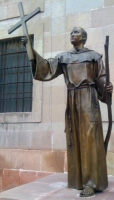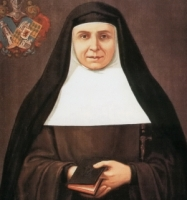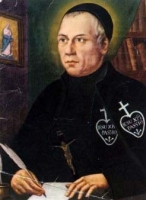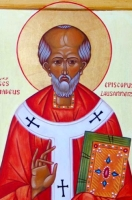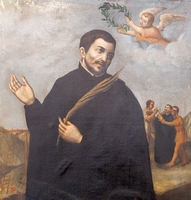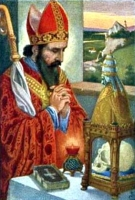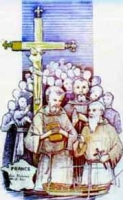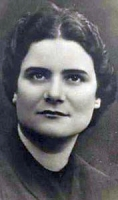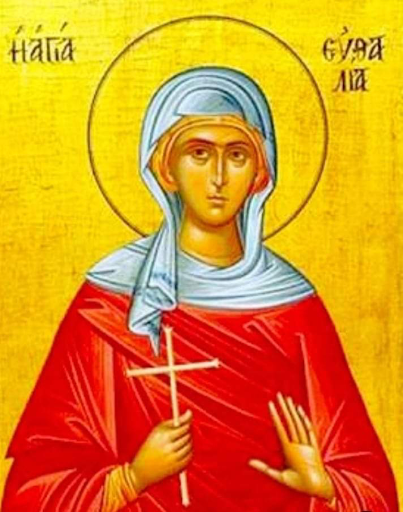.
Bl. Teresa Bracco
Feastday: August 28
Birth: 1924
Death: 1944
Beatified: Pope John Paul II
Teresa Bracco was born on 24 February 1924 in the village of Santa Giulia (Diocese of Acqui), Italy, to Giacomo Bracco and Anna Pera, two humble and devoutly Catholic farmers. From an early age she showed signs of great piety, particularly a love of the Eucharist and a tender devotion to the Virgin Mary. After a long day of tiring work, her father would lead the family in reciting the Rosary. Teresa learned to pray by following her parents' example.
The formation she received at home was strengthened by the catechesis given by an exceptional parish priest, Fr Natale Olivieri, who gave her many religious books to read but, most importantly, inspired her by his holy life.
At school, Teresa's teachers marveled at her exemplary conduct. As a young girl and throughout her adolescence she was often found in church with her eyes fixed on the tabernacle, immobile and almost ecstatic in the presence of the Blessed Sacrament. She spared no sacrifice to nourish her love for Christ in the Eucharist, rising early in the morning and walking over a kilometre to attend Mass and receive Holy Communion. She spent the rest of her day in work and prayer, fingering her rosary when her tasks allowed it.
One of her most striking virtues, however, was her modesty in speech and dress. She instinctively fled from trivial conversations. One witness said: "She was different from the other girls". At the age of nine, she saw a picture of the then Ven. Dominic Savio in the Bollettino Salesiano, with the caption: "Death rather than sin". She exclaimed: "That goes for me!". She cut out the picture, pasted it on a card and hung it over her bed It remained her favorite object of devotion for the rest of her life.
In the autumn of 1943 guerrilla warfare intensified in the Acqui region. The mountains and woods afforded many hiding places for partisans and draft resisters. On 24 July 1944 a fierce clash occurred between partisan forces and German troops on the road between Cairo Montenotte and Cortemilia. The next day the Germans returned to collect their dead: they burned farms, looted homes and terrorized the people.
They extended the round-up to the entire area and on 28 August reached Santa Giulia, which they thought was as a stronghold of the partisans, even though the latter had moved elsewhere. They seized three girls, one of whom was Teresa. A soldier, perhaps a non-commissioned officer, took her to a deserted place in the woods. Indomitable, Teresa tried to run from the thicket in the hope of getting help from a nearby family. But the ruffian grabbed her and threw her to the ground. She resisted the savage aggression with all her might, but the enraged soldier throttled her until she choked. He shot her twice with his revolver and to vent his rage, crushed part of her skull with his boot. Teresa had fulfilled her intention: "I would rather be killed than give in
Bl. Laurentia Herasymiv
Feastday: August 28
Birth: 1911
Death: 1952
Beatified: 27 June 2001 by Pope John Paul II
Laurentia Herasymiv was a nun who joined the Sisters of Saint Joseph in 1933 and was Martyred Under Communist Regimes in Eastern Bloc.
Saint Augustine of Hippo
புனிதர் அகஸ்டீன்
(St. Augustine of Hippo)
ஆயர், மறைவல்லுநர்:
(Bishop, Doctor of the Church)
பிறப்பு: நவம்பர் 13, 354
தகாஸ்ட், நுமீடியா
(தற்போதைய சூக் அஹ்ராஸ், அல்ஜீரியா)
(Thagaste, Numidia (Now Souk Ahras, Algeria)
இறப்பு: ஆகஸ்ட் 28, 430 (வயது 75)
ஹிப்போ ரீஜியஸ், நுமீடியா
(தற்போதைய அன்னபா, அல்ஜீரியா)
(Hippo Regius, Numidia (Now modern-day Annaba, Algeria)
ஏற்கும் சமயம்:
புனிதர்களை ஏற்கும் அனைத்து கிறிஸ்தவ சபைகள்
(All Christian denominations which venerate saints)
முக்கிய திருத்தலங்கள்:
புனித பியெட்ரோ தேவாலயம், சியேல் டி’ஓரா, பவீயா, இத்தாலி
(San Pietro in Ciel d'Oro, Pavia, Italy)
நினைவுத் திருவிழா: ஆகஸ்ட் 28
சித்தரிக்கப்படும் வகை:
குழந்தை; புறா; எழுதுகோல்; சங்கு; குத்தப்பட்ட இதயம்;
சிறுகோவிலைத் தாங்கும் புத்தகத்தைப் பிடித்திருத்தல்;
ஆயரின் ஊழியர்கள், ஆயரின் தொப்பி
பாதுகாவல்:
குடிபானம்; அச்சுப்பொறிகள்; இறையியலாளர்கள்; பிரிட்ஜ்போர்ட் (Bridgeport), கனெக்டிகட் (Connecticut); ககாயன் டி ஓரோ (Cagayan de Oro); ஃபிலிப்பைன்ஸ் (Philippines); சான் அகஸ்டின் (San Agustin); இசபெலா (Isabela)
புனிதர் ஹிப்போவின் அகஸ்டீன், கத்தோலிக்க திருச்சபையாலும், பிற பல கிறிஸ்தவ சபைகளாலும் பெரிதும் போற்றப்படுகின்ற தலைசிறந்த இறையியல் அறிஞர் ஆவார். இவர் இன்றைய அல்ஜீரியாவில் அமைந்திருந்த “ஹிப்போ ரீஜியஸ்” (Hippo Regius) என்னும் நகரத்தின் ஆயராக இருந்ததால் ஹிப்போ நகர் அகஸ்டீன் என அழைக்கப்படுகின்றார்.
இலத்தீன் மொழி பேசிய மெய்யியலாளரும், இறையியலாளருமான அகஸ்டீன் ரோமப் பேரரசின் பகுதியாக இருந்த வட ஆபிரிக்க மாகாணத்தில் வாழ்ந்தார். திருச்சபைத் தந்தையருள் ஒருவராகப் போற்றப்படும் இவர், மேலை நாட்டுக் கிறிஸ்தவத்தின் வளர்ச்சிக்கு முக்கிய பங்களித்தார். இளமைப் பருவத்தில் இவர் “மானி” (கி.பி. சுமார் 216-276) என்பவரால் தொடங்கப்பட்ட "மனிக்கேயிச" (Manichaeism) கொள்கையால் பெரிதும் கவரப்பட்டார். பின்னர் “புளோட்டினஸ்” என்னும் மெய்யியலாரின் கொள்கையிலிருந்து பிறந்த "நியோ-பிளேட்டோனிசம்" (neo-Platonism) என்னும் கொள்கையைத் தழுவினார்.
இக்கொள்கைகளால் அகஸ்டீனின் மெய்யியல் தேடலை நிறைவுசெய்ய இயலவில்லை. எனவே, கி.பி. 387ம் ஆண்டு, அகஸ்டீன் திருமுழுக்குப் பெற்று கிறிஸ்தவ சமயத்தைத் தழுவினார்.
கிறிஸ்தவர் ஆன பின்பு அகஸ்டீன் கிறிஸ்தவ மெய்யியல் மற்றும் இறையியல் கொள்கைகளை விரித்துரைப்பதில் ஈடுபட்டு, பல நூல்களை இயற்றினார். மனிதருக்கு சுதந்திரம் உண்டு என்று ஏற்றுக்கொண்ட அகஸ்டீன் கடவுளின் அருள் இன்றி மனித சுதந்திரம் செயல்பட இயலாது என்று கற்பித்தார். கிறிஸ்தவ சமயத்தின் ஒரு முக்கிய கொள்கையாகிய பிறப்புநிலைப் பாவம் (Original Sin) என்பது பற்றியும், போரில் ஈடுபடுவதற்கான நிபந்தனைகள் பற்றி நீதிப்போர் கொள்கை (Just War Theory) என்னும் தலைப்பிலும் அகஸ்டீன் எடுத்துக் கூறிய கருத்துருக்கள் கிறிஸ்தவத்தில் செல்வாக்குப் பெற்றன.
மேல்நாட்டில் ரோமப் பேரரசு குலைவடையத் தொடங்கிய காலத்தில், அகஸ்டீன் தாம் எழுதிய "கடவுளின் நகரம்" (City of God) என்னும் நூலில், திருச்சபை என்பது கடவுளை வழிபடுகின்ற சமூகம் என்பதால் ஆன்மிக முறையில் கடவுளின் நகரமாக உள்ளது என்றும், இது உலகம் என்னும் பொருண்மைசார் நகரத்திலிருந்து வேறுபட்டது என்றும் ஒரு கருத்தை முன்வைத்தார். இவரது சிந்தனைகள் மத்தியகால கலாச்சாரத்திலும் உலகநோக்கிலும் தாக்கம் கொணர்ந்தன.
கத்தோலிக்க திருச்சபையும், ஆங்கிலிக்கன் திருச்சபையும் புனித அகஸ்டீனைப் பெரிதும் போற்றுகின்றன. இச்சபைகளால் அவர் புனிதர் என்றும் தலைசிறந்த "திருச்சபைத் தந்தை" (Church Father) என்றும் மதிக்கப்படுகிறார். புனித அகஸ்டீனின் திருநாள் ஆகஸ்ட் மாதம், 28ம் நாள் கொண்டாடப்படுகிறது. அவர் இறந்த அந்நாள் அவர் விண்ணகத்தில் பிறந்த நாளாகக் கருதப்படுகிறது.
அகஸ்டீன் மனிதரின் மீட்புப் பற்றியும் கடவுளின் அருள் பற்றியும் அளித்த சிறப்பான போதனைகளின் காரணமாக, பல எதிர் திருச்சபைகள், குறிப்பாக "கால்வின் சபை" அவருக்குச் சிறப்பு மரியாதை அளிக்கின்றன; அவரை "திருச்சபை சீர்திருத்தத்தின் ஒரு முன்னோடி" என்று போற்றுகின்றன. கிழக்கு மரபு சபை அகஸ்டீனை "முக்திப்பேறு பெற்றவர்" என்று ஏற்று அவருடைய திருநாளை ஜூன் 15ம் நாள் கொண்டாடுகிறது.
அகஸ்டீனுடைய தந்தை, ரோம சமயத்தைச் (Pagan) சார்ந்த “பேட்ரீசியஸ்” (Patricius) ஆவார். இவர், தமது மரணப் படுக்கையில் கிறிஸ்தவராக மனம் மாறினார். அகஸ்டீனுடைய தாயார் பெயர், மோனிக்கா (Monica) ஆகும். இவர், ஒரு கிறிஸ்தவ பெண்மணியாவார்.
அகஸ்டீனின் தாயார் மோனிக்கா கிறிஸ்தவராக இருந்து தம் மகனைக் கிறிஸ்தவ சமயத்தில் வளர்த்த போதிலும், அகஸ்டீன் “மனிக்கேய” (Manichaeism) கொள்கையைத் தழுவி தம் தாயாரை மனம் நோகச் செய்தார்.
அகஸ்டீன் எழுதிய தன்வரலாறு நூலாகிய "Confessions" என்னும் புத்தகத்தில் தம் இளமைக்கால அனுபவங்களையும் தாம் தவறான வழியில் சென்றதையும் விரிவாக வடித்துள்ளார்.
அந்நூலில் காண்பதுபோல, அகஸ்டீன் கார்த்தேஜ் நகரில் ஓர் இளம் பெண்ணோடு தொடர்புவைத்து, அவரை முறைப்படி மணந்து கொள்ளாமலே பதினைந்து ஆண்டுகள் கழித்தார். அந்த உறவின் பயனாக அவருக்கு ஓர் ஆண்மகவு பிறந்தது. அக்குழந்தைக்கு அகஸ்டீன் "அடேயோடாடஸ்" (Adeodatus) என்னும் பெயரிட்டார்.
மோனிக்கா தம் மகன் அகஸ்டீனோடு மிலனுக்குச் சென்றிருந்தார். அங்கு தம் மகனுக்குப் பொருத்தமான ஒரு பெண்ணை மணமுடித்து வைக்க வேண்டும் என அவர் விரும்பினார். ஆனால் அகஸ்டீன் தாம் முதலில் அன்பு செய்த பெண்ணை மறக்கவில்லை. எனவே வேறொரு பெண்ணை மணக்க தயங்கினார். பின்னர் மண ஒப்பந்தம் ஆனது. ஆனால் அது முறிந்தது.
கி.பி. 386ம் ஆண்டு கோடைகாலத்தில் அகஸ்டீன் புனித வனத்து அந்தோனியார் (Saint Anthony of the Desert) என்னும் துறவியின் வாழ்க்கையைப் படித்தார். அதிலிருந்து தாமும் தூய வாழ்வு நடத்த வேண்டும் என்றும், தவறான கொள்கைகளைக் கைவிட வேண்டும் என்றும், கிறிஸ்தவத்தைத் தழுவ வேண்டும் என்றும் முடிவுசெய்தார். அம்முடிவோடு தம் ஆசிரியப் பணிக்கு முற்றுபுள்ளி வைத்தார். திருமணம் செய்யும் எண்ணத்தைக் கைவிட்டார். கடவுளுக்கே தம்மை முற்றிலும் அர்ப்பணிக்கத் தீர்மானித்தார்.
ஒருநாள் தோட்டத்தில் நடந்துகொண்டிருந்தபோது அகஸ்டீன் ஒரு குழந்தையின் குரலைக் கேட்டார். அக்குரல் அவரிடம் "எடுத்து வாசி" என்று கூறியது. முதலில் அக்குரலின் பொருளை அவர் உணரவில்லை. பிறகு, புனித வனத்து அந்தோனியாரின் வாழ்வில் ஏற்பட்ட அனுபவம் தம் வாழ்விலும் உண்மையாவதை அவர் உணர்ந்தார். "எடுத்து வாசி" என்னும் குரல் உண்மையாகவே கடவுளிடமிருந்து வந்ததாகவும், கடவுளுடைய வார்த்தை அடங்கிய திருவிவிலியத்தை எடுத்து வாசித்தால் தம் வாழ்வின் பொருளை அறிந்து கொள்ளலாம் எனவும் அவர் உள்ளூர உணர்ந்தார்.
உடனேயே திரும்பிச் சென்று விவிலியத்தைத் திறந்து வாசித்தார். அப்போது அவர் கண்களில் பட்டது தூய பவுல் உரோமையருக்கு எழுதிய திருமுகத்தில் ஒரு பகுதி இதோ:
"களியாட்டம், குடிவெறி, கூடா ஒழுக்கம், காமவெறி, சண்டைச்சச்சரவு, ஆகியவற்றைத் தவிர்ப்போமாக! தீய இச்சைகளைத் தூண்டும் ஊனியல்பின் நாட்டங்களுக்கு இடம் கொடுக்க வேண்டாம். இயேசு கிறிஸ்துவை அணிந்து கொள்ளுங்கள்."
~ உரோமையர் 13:13-14
இச்சொற்களை வாசித்த அகஸ்டீன், தம் வாழ்வில் அடிப்படையான மாற்றம் தேவை என்பதை உணர்ந்தார். கடவுளே தம் உள்ளத்தில் பேசுகிறார் என்பதையும் அறிந்தார். தம் தாய் மோனிக்கா கடவுளிடம் வேண்டிய மன்றாட்டுகள் வீண் போகவில்லை என்பதை அகஸ்டீன் உணர்ந்ததோடு, மிலான் நகர ஆயராகிய அம்புரோசு விவிலியத்தை விளக்கியுரைத்த பாணியாலும் கவரப்பட்டார். கிறிஸ்தவ சமயத்தில் கடவுளின் உண்மை உள்ளது என்று ஏற்றுக் கொண்டார்.
எனவே, மிலான் நகர ஆயராகிய அம்புரோசை அணுகி, தமக்குத் திருமுழுக்கு அளித்து தம்மைக் கிறிஸ்தவ சமயத்தில் ஏற்றுக்கொள்ள வேண்டுமென்று கேட்டுக்கொண்டார். அம்புரோசும் அதற்கு இணங்கி அகஸ்டீனுக்கும் அவருடைய மகன் ஆதோயோதாத்துசுக்கும் அகஸ்டீனின் நெருங்கிய நண்பரும் அவருக்குக் கிறிஸ்தவத்தில் ஆர்வத்தை எழுப்பியவருமாகிய அலீப்பியுஸ் (Alypius) என்பவருக்கும் திருமுழுக்கு அளித்து அவர்களைக் கிறிஸ்தவ சபையில் ஏற்றுக் கொண்டார்.
Also known as
• Aurelius Augustinus
• Doctor of Grace
Additional Memorial
5 May (his conversion)
Profile
Son of a pagan father who converted on his death bed, and of Saint Monica, a devout Christian. Raised a Christian, he lost his faith in youth and led a wild life. Lived with a Carthaginian woman from the age of 15 through 30. Fathered a son whom he named Adeotadus, which means the gift of God. Taught rhetoric at Carthage and Milan, Italy. After investigating and experimenting with several philosophies, he became a Manichaean for several years; it taught of a great struggle between good and evil, and featured a lax moral code. A summation of his thinking at the time comes from his Confessions: "God, give me chastity and continence - but not just now."
Augustine finally broke with the Manichaeans and was converted by the prayers of his mother and the help of Saint Ambrose of Milan, who baptized him. On the death of his mother he returned to Africa, sold his property, gave the proceeds to the poor, and founded a monastery. Monk. Priest. Preacher. Bishop of Hippo in 396. Founded religious communities. Fought Manichaeism, Donatism, Pelagianism and other heresies. Oversaw his church and his see during the fall of the Roman Empire to the Vandals. Doctor of the Church. His later thinking can also be summed up in a line from his writings: Our hearts were made for You, O Lord, and they are restless until they rest in you.
Born
13 November 354 at Tagaste, Numidia, North Africa (Souk-Ahras, Algeria) as Aurelius Augustinus
Died
28 August 430 at Hippo, North Africa
Patronage
• against sore eyes
• against vermin
• brewers
• printers
• theologians
• 7 dioceses
• 7 cities
Representation
• child
• dove
• eagle
• pen
• shell
• flaming heart, an allusion to a passage in his Confessions
Saint Edmund Arrowsmith
புனித எட்மண்ட் ஆரோஸ்மித் (1585-1628)
இவர் இங்கிலாந்து நாட்டைச் சார்ந்தவர். இவருடைய பெற்றோர் கத்தோலிக்க நம்பிக்கையில் மிக உறுதியாக இருந்தவர்கள். இதற்காகவே இவர்கள் ஆட்சியாளர்களால் பலவாறாகச் சித்திரவதை செய்யப்பட்டார்கள்.
தனது பெற்றோரின் இத்தகைய எடுத்துக்காட்டான வாழ்வால் தூண்டப்பட்ட இவர், அருள்பணியாளராக மாறி இறைப்பணியைச் செய்ய வேண்டும் என்று உறுதி கொண்டார். அதன்படி இவர் 1605 ஆம் ஆண்டு இங்கிலாந்து நாட்டை விட்டு டவாய் (Douai) என்ற இடத்திற்குச் சென்று குருத்துவப் படிப்பைப் படித்து, 1612 ஆம் ஆண்டு குருவாக அருள்பொழிவு செய்யப்பட்டார்.
இதற்குப் பிறகு இவர் லங்காஷிர் என்ற இடத்தில் 1622 ஆம் ஆண்டு வரை பணி செய்தார். இப்படி இருக்கையில் இவர் கத்தோலிக்க நம்பிக்கையை மக்கள் நடுவில் பரப்பி வருகிறார் என்று கைது செய்யப்பட்டு சிறையில் அடைக்கப்பட்டார். ஒரு சில நாள்களிலேயே இங்கிலாந்தை ஆண்ட வந்த ஜேம்ஸ் என்ற மன்னனின் உத்தரவின் பேரில் இவர் விடுதலை செய்யப்பட்டார்.
சிறையிலிருந்து விடுதலையான இவர் 1624 ஆம் ஆண்டு இயேசு சபையில் சேர்ந்து பணி செய்யத் தொடங்கினார். கடவுளின் வார்த்தையை மிகத் துணிவோடு அறிவித்து வந்த இவர் 1628 ஆம் ஆண்டு, 'ஒரு கத்தோலிக்கக் குருவானவர் இவர்' என்று காட்டிக் கொடுக்கப்பட்டு, தூக்கிலிடப்பட்டுக் கொல்லப்பட்டார்.
Also known as
• Brian Arrowsmith
• Edmund Bradshaw
• Edmund Rigby
Additional Memorial
• 25 October as one of the Forty Martyrs of England and Wales
• 29 October as one of the Martyrs of Douai
Profile
Son of the farmer Robert Arrowsmith and Margery Gerard Arrowsmith. His rebel parents refused to attend Protestant services, harbored priests in their home, and at one point were arrested for their actions, and dragged away in the night, leaving the child Edmund alone. Entered Douai College in 1605; he was forced to quit due to ill health. Ordained in France in 1611. Worked among beleaguered English Catholics in Lancashire for 15 years. Even in those oppressive times he was known for his pleasant disposition, sincerity, and energy.
Queen Elizabeth's governors and hierarchy lived on confiscated Catholic property, so public distrust of priests as agents of Catholic Spain working for a Spanish invasion, worked to their advantage, keeping the population in a constant state of paranoia, dependant on an intrusive government. To keep all this in place, Elizabeth had her own Inquisition. Edmund was arrested in 1622 for his faith, and spent his prison time arguing theology with the local Protestant bishop.
Edmund was unexpectedly freed by a pardon issued by King James I. After making the Spiritual Exercises, Edmund entered the Jesuits in 1623, and returned to Lancashire for the remaining five years of his life. Betrayed by the son of the landlord of the Blue Anchor Inn in south Lancashire, he was arrested by priest hunters, and imprisoned for his vocation. He decided to let the court prove the charge rather than help them with a confession, replying, "Would that I were worthy of being a priest!" When the jury found him guilty of being a Jesuit priest, he exclaimed, "Thanks be to God!" Brought to execution, he prayed for everyone in the kingdom, then said, "Be witnesses with me that I die a constant Roman Catholic and for Christ's sake; let my death be an encouragement to your going forward in the Catholic religion." His confession on the day of his execution was heard by fellow-prisoner Saint John Southworth, and his final words were "Bone Jesu" (O good Jesus).
Born
• 1585 at Haydock, Lancashire, England as Brian Arrowsmith
• his confirmation name was Edmund, and he preferred to use it
Died
• hanged, drawn, and quartered on 28 August 1628 at Lancaster, England
• his hand is preserved as a relic at Saint Oswald's Church, Ashton-in-Makerfield, England
Canonized
25 October 1970 by Pope Paul VI as one of the Forty Martyrs of England and Wales
Saint Junipero Serra
Also known as
• Apostle of California
• Miguel José Serra Ferrer
Additional Memorial
1 July (United States)
Profile
Entered the Franciscan University at Palma, Spain at age 15, and joined the Order at age 17, taking the name Junipero after the friend of Saint Francis. Ordained in 1737, and taught philosophy and theology at the Lullian University.
In 1749, Serra was sent to the missionary territories of the west of North America. A mosquito bite he received early in his trip to the New World left one leg swollen; this and his asthma made walking a painful process for the rest of his life. In 1768 he took over missions in the Mexican provinces of Lower and Upper California, missions the Jesuits were forced to abandon by order of King Charles III. A tireless worker, Serra was largely responsible for the foundation and spread of the Church on the West Coast of the United States. Founded twenty-one missions, converted thousands of Native Americans, and trained many of them in European methods of agriculture, cattle husbandry, and crafts. Dedicated religious and missionary, penitent and austere in all areas of his life.
Blessed Junipero Serra is the namesake of the Serra Club, an international Catholic organization dedicated to the promotion of vocations, and the support of seminarians and religious novices. Many of his letters and other writings have survived, and the diary of his travels to the west was published in the early 20th century.
Born
24 November 1713 at Petra, Spanish Majorca as Miguel Jose Serra
Died
• 28 August 1784 of tuberculosis at Mission San Carlos, California of natural causes
• buried at Carmel, Monterey, California
Canonized
• 23 September 2015 by Pope Francis
• canonization recognition celeberated at the Basilica of the Immaculate Conception, Washington, DC, presided by Pope Francis
Saint Vicinius of Sarsina
Also known as
Vicinio
Profile
Prayerful hermit on a mountain near Sarsina, Italy; it has since been named Monte San Vicinio in his honour. As was the custom then, around the year 303 the clergy and laity of Sarsina gathered to select their bishop; they saw a sign appear in the heavens above the mountain where Vicinius lived (one account gives it as angels in prayer over his hermitage), a group of the faithful was dispatched to find the man pointed out to them, and Vicinio was chosen the first bishop of Sarsina. Vicinius served for over 25 years, spreading the faith to the entire region. Even as bishop he regularly returned to the mountains to make solitary spiritual retreats. Miracle worker, exorcist and healer of both physical and mental illness.
As a personally imposed penance, for much of his life Vicinius wore an iron collar around his neck; it had a heavy stone attached by a chain. Healings he prayed for were especially powerful if the patient briefly wore the iron collar around his own neck. The collar has survived to today, and is still used for blessings of the sick, particularly those suffering from obsessions. Over the years a folk tradition developed of weaving collars of different coloured threads into “collars” as get-well wishes for the sick, and a reminder of the prayers for the intercession of Saint Vicinius; these collars, known as cordlens, are also blessed and given to the faithful during the celebration of the memorial on 28 August. Legand says that a beggar once tried to steal the collar and chain; he ran all night to escape the area only to find at dawn that he had been running in the same spot for hours; he threw the chain into the river where it floated until found by the locals and returned to its proper place.
Born
late 3rd century Liguria, Italy
Died
• 28 August 330 in the area of Sarsina, Italy of natural causes
• his relics, incuding the iron collar, are enshrined in the Basilica of San Vicinio
Patronage
Sarsina, Italy
Representation
• chain
• iron collar
Blessed Alfons Maria Mazurek
Also known as
• Alfons Maria of the Holy Spirit
• Alphonsus Mary of the Holy Spirit
• Joseph Mazurek
• Józef Mazurek
Additional Memorial
12 June as one of the 108 Martyrs of World War II
Profile
Discalced Carmelite friar, taking the name Alfons Maria of the Holy Spirit. Ordained in July 1916. Teacher and noted administrator. Professor at the Carmelite minor seminary. Prefect of the seminary. Prior of the Carmelite monastery at Czerna, Poland in 1930. Under his leadership, the house renewed their evangelization work in the community. Murdered by Nazis for being a Christian leader. Martyr.
Born
1 March 1891 at Baranówka, Lubelskie, Poland as Józef Mazurek
Died
beaten then shot on 28 August 1944 in Nawojowa Góra, Malopolskie, Poland
Beatified
13 June 1999 by Pope John Paul II at Warsaw, Poland
Blessed Thomas Felton
Profile
Son of Blessed John Felton, Thomas was about 4 years old when his father was martyred. In his youth, he served as a page to one Lady Lovett. Feeling a call to the priesthood, in 1583 Thomas began studying at the English College in Rheims, France. While still a seminarian, he joined the Order of Minims, but their severe austerity ruined his health, and he left his studies to return to England.
Incoming Catholic priests being illegal at the time, Thomas was immediately arrested and imprisoned in London for two years. Through the intervention of his aunt in the royal court, he was finally released. He tried to return to France to resume his studies, but was imprisoned for this offense. When he was released again, he tried to get to France again, and was imprisoned again, this time put to torture to break him from his desire to be a priest. Finally, after years of prison and abuse, he was brought to trial, and when he refused to accept the queen as head of the Church, he was condemned to death. Martyr.
Born
c.1567 in Bermondsey, London, England
Died
hanged on 28 August 1588 in Isleworth, London, England
Beatified
15 December 1929 by Pope Pius XI
Saint Joaquina Vedruna Vidal de Mas
Also known as
• Joachina de Vedruna
• Joachima de Vedruna
• Joaquima de Vedruna Vidal de Mas
• Joaquina of Saint Francis of Assisi
Profile
Married to the Spanish nobleman Theodore de Mas in 1799. Mother of nine children. Widowed in 1816. Founded the Institute of the Carmelite Sisters of Charity in 1826. The Institute spread through Catalonia with the mission of caring for the sick, and teaching children. Had a great devotion to the mystery of the Holy Trinity. Suffered a slow paralysis during the last four years of her life.
Born
16 April 1783 in Barcelona, Spain
Died
28 August 1854 at Vic, Barcelona, Spain of cholera
Canonized
12 April 1959 by Pope John XXIII
Patronage
• abuse victims
• death of children
• exiles
• widows
Saint Julian of Auvergne
Also known as
Julian of Brioude
Profile
Officer in the imperial Roman army, and a closet Christian. He retired from the army and fled to Auvergne, France during the persecutions of Diocletian. At one point he was hidden by Saint Ferreolus the Tribune. Julian later surrendered to pursuing Christian-hunters, and made a public announcement of his faith. Martyr. At least 80 French townships have some variant of his name.
Born
at Vienne, Dauphiny, Gaul (modern France)
Died
• beheaded near Brionde, Gaul
• water from a spring that grew nearby was later believed to cure headaches
• relics enshrined at the monastery of Saint Julian until destroyed by Norse invaders
• the site of the relics became known for miraculous cures, especially in the family of Saint Gregory of Tours, who wrote about them
Blessed Francisco Romero Ortega
Profile
The son of a tailor, the brother of Blessed José Romero Ortega, after studies at the seminary of San Indalecio de Almería, Francisco was ordained a priest in the diocese of Almería, Spain in May 1895; he served in this vocation for over 40 years. Parish priest in several location. Chaplain of the Servants of Mary in 1926. Served in the 1929 Synod of Almería. Martyred with his brother in the Spanish Civil War.
Born
30 March 1872 in Almería, Spain
Died
shot, blinded and burned on 28 August 1936 in Huércal, Almería, Spain
Beatified
• 25 March 2017 by Pope Francis
• beatification celebrated in the Palacio de Exposiciones y Congresos de Aguadulce, Almería, Spain, presided by Cardinal Angelo Amato
Blessed José Romero Ortega
Profile
The son of a tailor, the brother of Blessed Francisco Romero Ortega, after studies at the seminary of San Indalecio de Almería, José was ordained a priest in the diocese of Almería, Spain in December 1899. Chaplain of the hospital run by the Daughters of Charity. Parish priest in a number of places for 25+ years. Martyred with his brother in the Spanish Civil War.
Born
2 April 1875 in Almería, Spain
Died
shot on 28 August 1936 in Huércal, Almería, Spain
Beatified
• 25 March 2017 by Pope Francis
• beatification celebrated in the Palacio de Exposiciones y Congresos de Aguadulce, Almería, Spain, presided by Cardinal Angelo Amato
Saint Moses the Black
புனிதர் கருப்பரான மோசே
(St. Moses the Black)
துறவி, குரு, துறவு தந்தை:
(Monk, Priest and Monastic Father)
பிறப்பு: கி.பி. 330
எத்தியோப்பியா
(Ethiopia)
இறப்பு: கி.பி. 405
ஸ்கேடீஸ், எகிப்து
(Scetes, Egypt)
ஏற்கும் சமயம்:
ரோமன் கத்தோலிக்க திருச்சபை
(Roman Catholic Church)
கிழக்கு மரபுவழி திருச்சபை
(Eastern Catholic Churches)
ஆங்கிலிக்கன் ஒன்றியம்
(Anglican Communion)
லூதரனியம்
(Lutheranism)
ஒரியண்டல் மரபுவழி திருச்சபை
(Oriental Orthodoxy)
முக்கிய திருத்தலம்:
பரோமேயோஸ் மடம், ஸ்கேடீஸ், எகிப்து
(Paromeos Monastery, Scetes, Egypt)
நினைவுத் திருவிழா: ஆகஸ்ட் 28
பாதுகாவல்: ஆப்பிரிக்கா, அறப் போராட்டம்
“கருப்பரான புனிதர் மோசே” (Saint Moses the Black) அல்லது, “கொள்ளைக்காரான மோசே” (Abba Moses the Robber) என்று அழைக்கப்படும் இவர், நான்காவது நூற்றாண்டில், எகிப்து நாட்டில் வாழ்ந்து, கடும் தவம் செய்த துறவியும், கத்தோலிக்க குருவும், குறிப்பிடத்தக்க பாலைவனத் தந்தையருள் (Desert Father) ஒருவரும் ஆவார். இவர் “அறப் போராட்ட திருத்தூதர்” (Apostle of Non-Violence) எனவும் அழைக்கப்படுகின்றார்.
மோசே, ஒரு எகிப்திய (Egypt) அரசு அதிகாரியின் பணியாளாக இருந்தவர் ஆவார். திருடியதாகவும், கொலை செய்ததாகவும் சந்தேகிக்கப்பட்டு, இவர் பணிநீக்கம் செய்யப்பட்டார். பின்னர் இவர் கொள்ளைக்காரர்கள் (Bandits) கும்பல் ஒன்றின் தலைவர் ஆனார். நைல் பள்ளத்தாக்கில் (Nile Valley) பயங்கரவாத வன்முறை செயல்களில் ஈடுபட்டு வந்தார். இவர் வடிவில் மிகவும் பெரியதாயும் ஆதிக்கம் செலுத்துபவராகவும் இருந்தார்.
ஒரு சமயம், கொள்ளை நடத்த சென்ற இடத்தில் ஒரு நாய் குரைத்ததால் மோசே தனது திட்டத்தினை நிரைவேற்ற இயலவில்லை. அதனால் அவர் அதன் உரிமையாளர் மீது பழிவாங்கும் நோக்கோடு அவரது வீட்டினை கொள்ளை இட மீண்டும் முயன்றார். நாய் மீண்டும் தடுக்கவே, தனது கோபத்தை தணிக்க அவரது ஆடுகளில் சிலவற்றை கொன்றார். ஒருமுறை உள்ளூர் அதிகாரிகளிடமிருந்து தப்பிக்கும் முயற்சியாக அலெக்சாந்திரியாவுக்கருகே (Alexandria) இருந்த “ஸ்கேடீஸ்” (Scetes) என்னும் பாலைவனத்தில் வாழ்ந்துவந்த துறவிகளிடம் அடைக்கலம் புகுந்தார். அங்கு இருந்த துறவியரின் அர்ப்பண வாழ்வு, அவர்களின் அமைதி மற்றும் மனநிறைவு ஆகியவை மோசேவிடம் ஆழ்ந்த தாக்கத்தை ஏற்படுத்தியது. அதன் விளைவாக அவர் விரைவில் தனது பழைய வாழ்க்கையினை கைவிட்டு, ஒரு கிறிஸ்தவராக திருமுழுக்கு பெற்று, அத்துறவியர்களின் குழுவில் ஒரு துறவியாக இணைந்தார்.
துறவு வாழ்வு இவருக்கு முதலில் கடினமாகவே அமைந்தது. இவரின் முரட்டு குணம் இவரை அடிக்கடி மனம் தளர வைத்தது. எனினும் தொடர்ந்து தனது ஆன்மீக வாழ்வில் முன்னேறி பல கடும் தவ முயற்சிகளில் ஈடுபட்டார். பின்னாட்களில் இவர் வட ஆபிரிக்காவின் மேற்கு பாலைவனத்தில் (Western Desert) இருந்த வனவாசிகளுக்கு ஆன்மீக தலைவரானார். அப்போது இவர் ஒரு குருவாக திருநிலைப்படுத்தப்பட்டார்.
இவருக்கு 75 வயதானபோது, கி.பி. 405ம் ஆண்டு, “பெர்பர்களின்” (Berbers) ஒரு குழு மடத்தினை தாக்கி அதனை சூறையாட திட்டமிட்டிருப்பதாக இவருக்கு செய்தி வந்தது. இம்மடத்தில் இருந்த பிற துறவிகள் அவர்களை எதிர்த்து போராட விரும்பினாலும், இவர் அதற்கு அனுமதி வழங்கவில்லை. அம்மடத்தில் இருந்த ஏழு துறவிகளைத்தவிர மற்ற எல்லோரையும் பாதுகாப்பான இடத்திற்கு அனுப்பிவிட்டு படையெடுப்பாளர்களை கைவிரித்து வரவேற்றார். இவரும் இவருடன் மடத்தில் இருந்த எழுவரும் அப்படையெடுப்பாளர்களால் ஜூலை மாதம், 1ம் தேதியன்று, கொல்லப்பட்டனர். இவர் ஒரு மறைசாட்சியாக கருதப்படுகின்றார்.
Also known as
• Moses the Ethiopian
• Moses of Scete
Profile
Born into slavery to an Egyptian official's family. An unruly thief, he was driven from the house and fell in with a band of robbers. On the run, he took refuge with hermits at the monastery of Petra in the desert of Skete, Egypt. He was converted and joined them as a monk. Priest. Possessed of supernatural gifts. A confirmed pacifist, he refused to defend himself with his monastery was attacked.
Born
330; Ethiopian ancestry
Died
• murdered 405 by Berbers at Petra, Skete, Egypt
• relics at the Church of Al Adra (the Virgin)
Patronage
Africa
Blessed Charles-Arnould Hanus
Profile
Priest in the diocese of Verdun France. Dean of the Chapter of Ligny, Meuse, France. Imprisoned on a ship in the harbor of Rochefort, France and left to die during the anti-Catholic persecutions of the French Revolution. One of the Martyrs of the Hulks of Rochefort.
Born
18 October 1723 in Nancy, Meurthe-et-Moselle, France
Died
28 August 1794 aboard the prison ship Washington, in Rochefort, Charente-Maritime, France
Beatified
1 October 1995 by Pope John Paul II
Blessed Hugh More
Additional Memorials
• 29 October as one of the Martyrs of Douai
• 1 December as one of the Martyrs of Oxford University
Profile
Educated in England at Oxford and Gray's Inn. Converted to Catholicism. Studied and was ordained at Rheims, France, then returned to England to minister to covert Catholics during a period of persecution. For this crime he was martyred.
Born
at Grantham, Lincolnshire, England
Died
hanged on 28 August 1588 at Lincoln's Inn Fields, London, England
Beatified
15 December 1929 by Pope Pius XI
Blessed Angelo da Pesche d'Isernia
Profile
Franciscan tertiary who worked as gardener and beggar for several Franciscan houses in southern Italy. Known for his personal piety, humility and deep prayer life, he was a much sought spiritual advisor. Reported to have levitated in ecstacy when hearing music that made him think of the heavenly choir.
Born
c.1400 in Pesche d'Isernia, Italy
Died
• 1460 in the Franciscan monastery in Lucera, Foggia, Italy of natural causes
• buried in Puglia, Italy
Blessed James Claxton
Also known as
James Clarkson
Additional Memorial
29 October as one of the Martyrs of Douai
Profile
Raised a devout Catholic. Educated and ordained at Rheims, France in 1582. He returned to England to minister to covert Catholics in Yorkshire, for which ministry he was martyred.
Born
16th century Yorkshire, England
Died
hanged, drawn, and quartered in 28 August 1588 at Ilseworth, London, England
Beatified
15 December1929 by Pope Pius XI
Saint Hermes of Rome
Profile
Wealthy freed Roman slave. Brother of Saint Theodora of Rome. Martyr. A catacomb in the Salesian Way bears his name.
Died
• martyred c.125 at Rome, Italy
• relics at Acquapendente, Italy; Salzburg, Austria; Kornelimünster Abbey; San Marco of Rome), Italy; and Seligenstadt, Germany
Patronage
• Forte dei Marmi, Lucca, Italy
• Acquapendente, Italy
Blessed William Dean
Profile
Protestant minister who converted to Catholicism. Studied for the priesthood at Rheims, France. Ordained in 1581. He then returned to England as a home missioner. Arrested and exiled for his work, he returned and was arrested in London. Condemned to death for the crime of priesthood. Martyr.
Born
at Linton-in-Craven, Yorkshire, England
Died
28 August 1588 at Mile End Green, East London, England
Beatified
15 December 1929 by Pope Pius XI
Blessed Henry Webley
Additional Memorial
22 November as one of the Martyrs of England, Scotland, and Wales
Profile
Layman in the apostolic vicariate of England. Martyred in the persecutions of Queen Elizabeth I.
Born
in Gloucester, Glocestershire, England
Died
hanged, drawn and quartered on 22 August 1588 in Mile End Green, London, England
Beatified
22 November 1987 by Pope John Paul II
Saint Florentina of Cartagena
Also known as
Florence, Fiorentina
Profile
Sister of Saint Leander of Seville, Saint Fulgentius of Ecija and Saint Isidore of Seville. Orphaned young and raised by Saint Leander of Seville. Nun. Abbess.
Born
Cartagena, Spain
Died
c.636 of natural causes
Saint Alexander of Constantinople
Additional Memorial
30 August (Greek calendar)
Profile
First bishop of Constantinople. Fought Arianism and turned away the writings of Arius from entering his diocese. Assisted at the Council of Nice.
Died
340
Blessed Adelindis of Buchau
Also known as
• Adelindis of Poulagy
• Adelinda, Adele, Adelaide
Profile
Married. Widow. Founded Buchau Abbey in Württemberg, Germany, entered it as a nun, and later served as its abbess.
Died
c.930
Saint Pelagius of Istria
Also known as
Pelagio
Profile
Boy martyred in the persecutions of Numerian.
Died
• c.283 in Istria (part of modern Croatia)
• relics transferred to Città Nuova, Istria
• some relics transferred to Constance, Germany
Patronage
Constance, Germany
Saint Vivian of Saintes
Also known as
Bibiano
Profile
Bishop of Saintes, France. Protected his people during the Visigoth invasion.
Born
c.419
Died
• c.460 at Saintes, France of natural causes
• some relics enshrined in Figeac, France
• some relics enshrined in Rouen, France
Blessed Robert Morton
Profile
Priest in the apostolic vicariate of England. Martyred in the persecutions of Queen Elizabeth I.
Born
Bawtry, Yorkshire, England
Died
28 August 1588 in Lincoln’s Inn Fields, London, England
Beatified
22 November 1987 by Pope John Paul II
Blessed William Gunter
Profile
Priest in the apostolic vicariate of England. Martyred in the persecutions of Queen Elizabeth I.
Born
Raglan, Monmouthshire, Wales
Died
28 August 1588 in Shoreditch, London, England
Beatified
22 November 1987 by Pope John Paul II
Saint Septiminus of Venosa
Additional Memorial
1 September as one of the Twelve Holy Brothers
Profile
Martyred in the persecutions of Maximian Herculeaus.
Died
• c.303 at Venosa, Italy
• relics enshrined in Benevento, Italy in 760
Saint Januarius of Venosa
Additional Memorial
1 September as one of the Twelve Holy Brothers
Profile
Martyred in the persecutions of Maximian Herculeaus.
Died
• c.303 at Venosa, Italy
• relics enshrined in Benevento, Italy in 760
Saint Fortunatus of Salerno
Profile
Martyred in the persecutions of Diocletian.
Died
• 303 near Salerno, Italy
• relics enshrined in Salerno in 940
Saint Felix of Venosa
Additional Memorial
1 September as one of the Twelve Holy Brothers
Profile
Martyred in the persecutions of Maximian Herculeaus.
Died
• c.303 at Venosa, Italy
• relics enshrined in Benevento, Italy in 760
Saint Rumwold the Prince
Also known as
Rumwald
Profile
Born a prince. When he was three days old, Rumwold was baptised, spoke a profession of his faith, and then died.
Died
c.650
Saint Gaius of Salerno
Also known as
Caius
Profile
Martyred in the persecutions of Diocletian.
Died
• 303 near Salerno, Italy
• relics enshrined in Salerno in 940
Saint Gorman of Schleswig
Profile
Benedictine monk at Reichenau, Germany. Missionary preacher throughout northern Europe. Bishop of Schleswig, Denmark.
Died
965 of natural causes
Saint Anthes of Salerno
Profile
Martyred in the persecutions of Diocletian.
Died
• 303 near Salerno, Italy
• relics enshrined in Salerno in 940
Saint Agnes of Cologne
Profile
One of the young women who travelled with and was martyred with Saint Ursula. Venerated at Cologne, Germany.
Born
British Isles
Saint Restitutus of Carthage
Also known as
Restituto
Profile
Bishop of Carthage in North Africa.
Died
c.360
Saint Ambrose of Saintes
Profile
Bishop of Saintes, France for about 14 years.
Died
c.450
Saint Facundinus of Taino
Profile
Bishop of Taino, Italy.
Died
c.620
Martyred in the Spanish Civil War
Thousands of people were murdered in the anti-Catholic persecutions of the Spanish Civil War from 1934 to 1939. I have pages on each of them, but in most cases I have only found very minimal information. They are available on the CatholicSaints.Info site through these links:
• Blessed Agustín Bermejo Miranda
• Blessed Alejandro Iñiguez De Heredia Alzola
• Blessed Andrés Merino Báscones
• Blessed Antonio Solá Garriga
• Blessed Arturo Ros Montalt
• Blessed Aurelio da Vinalesa
• Blessed Celestino Ruiz Alegre
• Blessed Cesáreo España Ortiz
• Blessed Eladi Peres Bori
• Blessed Evencio Castellanos López
• Blessed Francisco López Navarette
• Blessed Germán Arribas y Arribas
• Blessed Graciliano Ortega Narganes
• Blessed Isidre Fábregas Gils
• Blessed Jaume Tarragó Iglesias
• Blessed Javier Pradas Vidal
• Blessed Joan Tomás Gibert
• Blessed Joaquim Oliveras Puljarás
• Blessed José Gorastazu Labayen
• Blessed Josep Camprubí Corrubí
• Blessed Juan Bautista Faubel Cano
• Blessed Lázaro Ruiz Peral
• Blessed Manoel José Sousa de Sousa
• Blessed Modest Godo Buscato
• Blessed Modest Pamplona Falguera
• Blessed Nicolás Rueda Barriocanal
• Blessed Serviliano Solá Jiménez
• Blessed Teodoro Pérez Gómez
Also celebrated but no entry yet
• Our Lady of Mailane
• Diego de Tahust
• Feidlimid
• Hezekiah of Judah
• Thomas Holford





